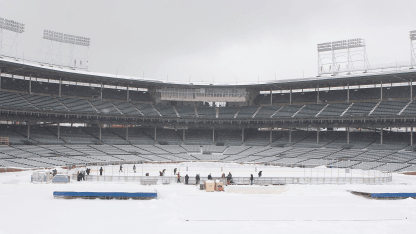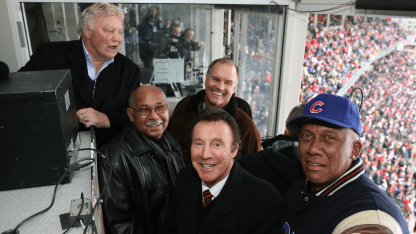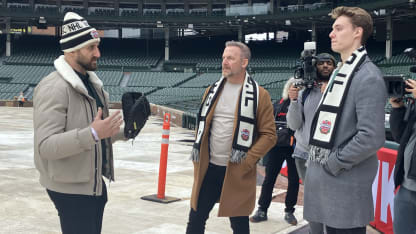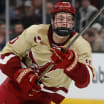“It was embarrassing until I looked over and I saw my two sons (Dean and Jake) watching the game along the boards. They got on the field, so when I looked at them, I started laughing. They were asking me what was going on and I literally started chuckling. At the time Brad McCrimmon was the assistant coach. He felt so bad. He was the one who had to come down and tell me after seven minutes that Babcock told him not to play me another shift.”
Kris Versteeg gave the Blackhawks a 1-0 lead at 3:24 before Mikael Samuelsson tied it for the Red Wings at 9:50. Martin Havlat scored at 12:37 and Ben Eager at 19:18 to give Chicago a 3-1 lead after one.
Andrew Ladd, Blackhawks forward: “I think the first goal’s always the memorable one. It set the tone for the entire feeling of getting the crowd into it. And I remember Benny’s (Eager) goal, his celebration.”
Campbell: “The bench was good. I think players just kind of keep going and keep the momentum going. You just know it means a lot to your fans when you’re playing at home, if you can win.”
Kal: “It was 3-1 Chicago after the first period. I’m thinking, ‘Well these outdoor games are not too fun.’”
MacLean: “We were kind of guilty of feeling our way around and kind of looking around and seeing how things were going to go, maybe thinking it’d go our way if we just show up, type of thing.”
Cornelison: “They looked on fire. And Bobby (Hull) being Bobby, he sat there in the suite, maybe grouchy is the word, and said, ‘Ah, don’t mean nothing. Whatever team scores the first goal in the second period, they win the game.’”
Red Wings forward Jiri Hudler scores 1:14 into the second period, the first of five unanswered goals for Detroit.
Ladd: “The game script for that game was probably similar to that whole season and how it ended with Detroit: they (Red Wings) taught us a few lessons and that was probably the one I remember most. They play their game and at that time we were running around and eventually they took over with their experience.”
Kal: “It seemed to me in that second period, my attitude changed. ‘Hey, I like these outdoor games.’ (laughs).”
Campbell: “I think we were a little complacent sometimes and obviously Detroit was what they were, a really good team with a lot of firepower.”
One of those five unanswered goals was from Hockey Hall of Famer Pavel Datsyuk, who scored after getting the puck at center ice from forward Johan Franzen.
Sharp: “Datsyuk scored a beautiful goal on us, unfortunately. He split our defensemen (Campbell and Cameron Barker) and made a great move on the goalie. You talk about the (Pittsburgh Penguins captain Sidney) Crosby goal in Buffalo (the first Winter Classic), it was the Datsyuk goal at Wrigley. It was a sick goal by Pavel Datsyuk for sure.”
Ladd: “I still remember Datsyuk’s goal, which was a heartbreaker for us at the time.”
As the game continued, the “Windy City” became just that.
Olczyk: “Datsyuk scored a breakaway goal, and we used the phrase it was wind-aided because he got the puck at the red line and all of a sudden, he’s between both Hawks defensemen and next thing you know the puck’s in the back of the net.”
Campbell: “It affected that day, so I think the second period was probably, if you were defending that way, wasn’t going to be the easiest that way as well.”
Draper: “You’re skating around to start the third period, and you could really feel that the wind had picked up for sure. I can’t remember if it was before the period started or just when it started, but you could really feel the advantage of the difference between being downwind and skating into the wind. And what they ended up having to do was basically say, 10 minutes each, then switch ends, because the wind was so bad.”
With the Red Wings up 6-3 in the third period, Blackhawks ambassadors Savard and the late Bobby Hull, Stan Mikita and Tony Esposito and former Cubs great Ryne Sandberg teamed up for the traditional baseball seventh-inning stretch rendition of “Take Me Out to the Ballgame.” It was revamped for the Winter Classic, “Take Me Out to the Hockey Game.”











































